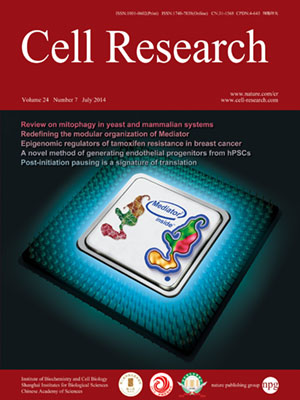
Volume 24, No 7, Jul 2014
ISSN: 1001-0602
EISSN: 1748-7838 2018
impact factor 17.848*
(Clarivate Analytics, 2019)
Volume 24 Issue 7, July 2014: 796-808 | Open Access
ORIGINAL ARTICLES
Redefining the modular organization of the core Mediator complex
Xuejuan Wang1, Qianqian Sun1, Zhenrui Ding1, Jinhua Ji1, Jianye Wang1, Xiao Kong1, Jianghong Yang1 and Gang Cai1,2,3
1School of Life Sciences, University of Science and Technology of China, 443 Huang-Shan Road, Hefei, Anhui 230027, China
2Hefei National Laboratory for Physical Sciences at the Microscale, Center for Integrative Imaging, 443 Huang-Shan Road, Hefei, Anhui 230027, China
3Center for Biomedical Engineering, University of Science and Technology of China, 443 Huang-Shan Road, Hefei, Anhui 230027, China
Correspondence: Gang Cai, Tel/Fax: 86 551 63603802(gcai@ustc.edu.cn)
The Mediator complex plays an essential role in the regulation of eukaryotic transcription. The Saccharomyces cerevisiae core Mediator comprises 21 subunits, which are organized into Head, Middle and Tail modules. Previously, the Head module was assigned to a distinct dense domain at the base, and the Middle and Tail modules were identified to form a tight structure above the Head module, which apparently contradicted findings from many biochemical and functional studies. Here, we compared the structures of the core Mediator and its subcomplexes, especially the first 3D structure of the Head + Middle modules, which permitted an unambiguous assignment of the three modules. Furthermore, nanogold labeling pinpointing four Mediator subunits from different modules conclusively validated the modular assignment, in which the Head and Middle modules fold back on one another and form the upper portion of the core Mediator, while the Tail module forms a distinct dense domain at the base. The new modular model of the core Mediator has reconciled the previous inconsistencies between the structurally and functionally defined Mediator modules. Collectively, these analyses completely redefine the modular organization of the core Mediator, which allow us to integrate the structural and functional information into a coherent mechanism for the Mediator's modularity and regulation in transcription initiation.
10.1038/cr.2014.64
FULL TEXT | PDF
Browse 2197


